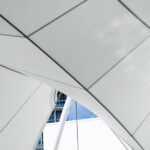Marking the inaugural exhibition at Gong Gallery, situated along the scenic Newport Beach coastline, “Affectionate and Continuous” emerged as a group show of three female Taiwanese artists. This exhibition was a celebration of womanhood, casting a spotlight on the nuanced identities and viewpoints of women through art. Among the featured artists was Haiwei “Jojo” Yeh, a versatile artist and designer whose current endeavors bridge the organic and the technological. Yeh’s innovative work is a dialogue with the elements, an intersection of space, nature, and sustainability, using a palette of natural materials complemented by the precision of digital innovation.
In her featured installation work “Back to Nature”, Jojo Yeh used paper mulberry tree fiber to mimic the true texture of trees, in an attempt to bring nature indoors. Her artwork profoundly underscores the symbiotic relationship we share with the natural realm, encapsulating the harmonious coexistence between Aboriginal culture and the environment. It beckons us to delve deeper into the formidable essence of nature and to ponder our role in safeguarding this cherished sanctuary we call home. Through the lens of arboreal life, this piece aspires to evoke a sense of wonder and veneration for the natural world, spurring a collective commitment to nurture and sustain the vitality of our planet.
In her artistic process, Yeh contemplates about nature and its dwellers as conscious beings of their own sense, beyond human understanding. She appears to engage deeply with the philosophical and existential musings on the intrinsic value and complex beauty of plant life – a theme that resonates with an ecocentric approach to art. “Back to Nature”, therefore, is no longer simply a furnishing piece in one’s home or other types of interior space, but rather a warm welcome to invite the natural beings into one’s house to coexist in harmony. By centering plants not just as subjects but as active agents with possibly their own forms of understanding and communication, the artwork nudges viewers towards a contemplative stance regarding the non-human world.
1. Your work brings a piece of the natural world into a gallery setting – how do you hope this affects the viewers’ perception of space and light?
By utilizing natural elements, I hope to blur the boundaries between the indoor and outdoor space and thus creating a unique connection with nature. The interplay between natural materials and light not only alters the visual effects, but it also enhances the viewer’s understanding of the interaction between light and nature. Additionally, it raises awareness of the coexistence of artificial and natural environments.
2. How do you believe your work, especially with the use of natural materials, resonates with the audience in the context of digital technology’s prevalence in modern life?
In this digital age, the warmth, texture, and organic nature of natural materials create a contrast with the screen-centered world we live in while also evoking emotions about nature, tradition and sustainability. Therefore, a richer sensory experience through touch and interaction will allow viewers to feel closer to nature.
3. How do you incorporate natural elements into other aspects of your practice, like design, painting and ceramics?
Nature is my muse, and the textures, shapes, colors and ecosystems found in nature are where I draw my artistic inspiration from. For example, I utilize bark fibers as a medium in an installation. With ceramics, I use the texture of plants to decorate the surface of the pottery, and I design totems that incorporate different spaces found in nature. Then, in my paintings, I use a nature-inspired color palette.
4. As a female Taiwanese artist, how do your cultural identity and experiences influence your artistic expression?
Taiwan is a multicultural and free country, influenced by Han Chinese culture, aboriginal culture, and other cultures. This cultural diversity has inspired me to explore and integrate different artistic mediums. These cultural backgrounds and Taiwan’s natural environment are deeply integrated into my artistic expression, making me an artist/designer concerned with nature, ecology, and sustainability. My works aim to inspire viewers to value nature and to appreciate Taiwan’s culture and nature.
5. What role do you feel artists have in addressing global issues like environmental conservation and cultural preservation?
Artists have the power to bring awareness to prevalent global issues. Through various mediums, artists can express their emotions, which can then resonate with the audience. At the same time, they can also present problems through their works, provoking the audience to engage in dialogues, thus increasing the visibility of these issues.
6. Your work suggests a deep connection with nature. Do you have any personal rituals or practices that help maintain this connection in your daily life?
In addition to gardening, I try to spend time outdoors every day to be close to nature. This can be as simple as taking a walk, outdoor sketching, botanical garden visits, etc. These activities help me maintain a sense of connection with nature. While I am outdoors, I also like to use my phone to capture still shots of beautiful moments in nature. These everyday practices help me maintain a deep connection with nature, which becomes the creative drive behind my artworks.
Yeh’s approach to art is deeply philosophical and eco-centric. She sees nature and its inhabitants as entities with their own consciousness, urging a contemplation of the intrinsic value and beauty of nature. Also, she regards human interaction with nature not only as a source of inspiration but as an essential element of human existence. Her work is more than decorative; it is an invitation to coexist harmoniously with nature in our living spaces – Yeh nudges her audience towards a deeper appreciation of the non-human world. Her use of natural materials in a digitally dominated age offers a tactile contrast, fostering a richer sensory experience that connects viewers with nature. This connection is further deepened by her incorporation of natural elements into various facets of her practice, including design, painting, and ceramics, where she draws inspiration from the textures, shapes, and colors of nature.
As a female Taiwanese artist, her cultural identity and experiences deeply influence her artistic expression, integrating Taiwan’s multicultural environment and natural beauty into her work. Additionally, Yeh sees artists as crucial in raising awareness of global issues like environmental conservation and cultural preservation, using their work to engage and inspire audiences towards these causes. Holding the natural elements dear as her muse, Jojo Yeh’s practice is inspiring and refreshing while contemplative and profound at the same time.
















